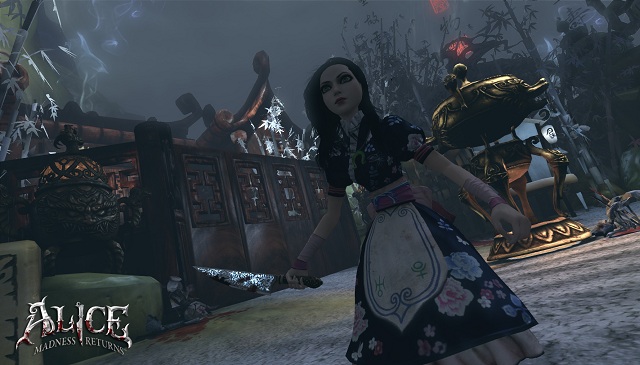"It's a poor sort of memory that only works backwards." – Through the Looking Glass
At the tender age of 11, I was gifted a copy of American McGee’s Alice for PC—despite its 'M' rating—by my parents. I had watched them play it, and I had gushed about how cool everything looked, and how much I liked the music. I had read my mother’s childhood copies of Alice’s Adventures in Wonderland and Through the Looking Glass several years before, and American McGee’s Alice eventually became as beloved to me as my gold-leafed, hardcover copies of those books.
The point being, after fervently hoping for and then waiting over a decade on Alice: Madness Returns, I am not in the least bit disappointed. My only regret is that the three-piece Mad Alice costume doesn’t seem to come in my child-like size.
Alice: Madness Returns absolutely does not fall into the category of bad sequel. Roughly a decade after the original, Alice again mentally revisits the past events of her family’s horrific death in a house fire. Rather than simply being a prettier revision of its predecessor, Madness Returns features an older, much more disturbed young woman with one hell of an imagination—and a more extensive wardrobe!
Wonderland is again in peril as Alice is haunted by repressed memories of the fire and begins to question if her family’s death was truly accidental as she previously thought. To discover the truth and retain (or regain?) sanity, Alice must revisit her beloved Wonderland and collect her memories to discover the truth, visit her old “friends”, and destroy wicked enemies with an impressive new collection of weapons and abilities.
Each and every detail of Wonderland and the "real world" has very obviously been lovingly and painstakingly designed. Within each chapter of Wonderland, the surroundings (and some enemies) all follow a certain theme—some of which include the Mysterious East and a Dollhouse. No matter the theme, it’s always uniquely and wonderfully disturbing.
Certain motifs are repeated and found throughout each area, but you’re never left feeling as if you’ve been wandering through the same place for an extended period of time. The variety of imagery makes Wonderland feel massive in size and a pleasure to explore. Much of the imagery can be loosely compared to existing creations based on Alice in Wonderland, but this creation is undeniably original and complex.
Throughout Alice: Madness Returns, there’s a whole lot of platforming. With the addition of a mighty jumping and floating ability, it’s less of a nightmare than Alice’s last trip to Wonderland (though perhaps it was only that difficult because I was 11). However, many of the platforms are invisible and only stay visible shortly after using the Shrink Vision ability. This can be frustrating but is mostly challenging in an enjoyable way.

One delightful aspect of this feature: Once the platforms disappear from view, you’re often left standing over a great dark abyss or terrifying pit of something-or-other—all while an equally disturbing enemy is in hot aerial pursuit. The effect is dizzying. I can only imagine how much more fun it would be with a fear of heights!
Jumping and floating to and from invisible (and did I mention often moving?) platforms, however, isn’t all there is to do in Wonderland. A pleasant variety of gameplay styles are scattered throughout, including slides (often made of something terrifying) with obstacles, side-scrolling shooting and adventuring, various puzzles, as well as the hidden Radula Rooms, which involve a small variety of challenges from riddles to hacking and slashing and splashing and peppering and smashing depending upon your weapon of choice.
Weaponry itself is as diverse and exciting as the enemies found throughout each chapter, and they are acquired at a pleasing pace. They can be upgraded at an equally pleasing pace if one is diligent at acquiring Teeth, which are dropped by enemies, as well as found throughout chapters on platforms or hiding in things like snail shells or cakes (Wonderland is probably the only place you’ll ever be excited to find teeth in your cake).
The Vorpal Blade makes a return as the “default” weapon, but now a charming choice of explosives, long-ranged and blunt-force weapons are part of Alice’s repertoire and must be used not only on enemies, but on the surrounding environment as well. The “Hobby Horse” is a personal favorite—it is incredibly powerful and it actually neighs! My inner-child nearly faints from joy with every bone-crushing swing.
Despite all the fun there is to be had with Alice in her Wonderland, not all is well. One thing is truly problematic with this title—it feels unfinished, as if it was released too quickly. After a decade of waiting for a sequel, it’s difficult to even associate the game with the phrase “too quickly”, but there are frequent indicators that this could be the case.

Some textures throughout are more pixilated and awful than a hastily-made user-created wallpaper you’d download for The Sims 2. On more than one occasion, I’d simply be standing and looking around, taking in all the details and glory of whichever environment I was in, and there’d be a giant blotchy mess that stuck out like a sore thumb next to its glossy, polished, and probably blood-splattered neighbors.
These instances were noticeable while on the move as well, and it always brought me right out of Wonderland and back onto my couch (in my pajamas and covered in cats) for a moment. Other in-game moments did the same—Alice sticking not only the Vorpal Blade through her dress but her entire forearm, enemies shooting fireballs and hot tea at walls and running off of platforms on a whim (maybe Wonderland is stressful for them, too?), a jet of flames shooting directly through Alice’s body without bothering to take away any health, and so on. There aren’t too many large-world platforming games out there without little bugs like these, but the frequency was occasionally alarming.
The audio also sounds terribly compressed during cut-scenes. It's distracting and detracts from the creatively and deliciously dark quality of the scene. The transition between cut-scenes and gameplay—throw in the loading screens as well—is often awkward and abrupt, which throws off the story and tension as well.
If these factors sound awful to you, fear not—that’s all I’ve got to gripe about. The overall quality of Alice: Madness Returns is high, despite it feeling rushed. The qualities that made American McGee’s Alice so enjoyable—the gory hack-'n'-slash combat, the gorgeous design, the rich dialogue, the menacing mood—are present and abundant. The art book alone is worth checking out, even if you never so much as manage to watch a trailer for this game. If any of those qualities sound at all like your cup of tea, don’t pass up Alice: Madness Returns.
-
Amazing environment and character designs
-
Variety of entertaining gameplay styles
-
Overall satisfyingly creepy design and story
-
Feels rushed, unfinished










